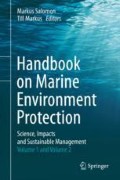Abstract
This chapter provides a short overview on the historical background of marine environmental pollution by hazardous substances and the measures implemented to minimize its amount and impact. In order to better understand the problems involved with contaminants in the marine environment, the basic common principles, e.g. their physico-chemical properties, persistency, behavior, and environmental impacts are described. Sources and fate of chemicals as well as their way into the environment also belong to the factors which are needed to know in order to assess the environmental risks of contaminants and protect the environment from its exposure and effects.
Examples are given for selected contaminants synthetized and used during different periods, starting in the mid of 1900 until the first decade of 2000, representing different classes of compounds: organochlorines (PCBs), organometals (TBT), and pharmaceuticals. For those examples, also information about the current status in areas of the Northeast Atlantic or the Baltic Sea is provided together with references and sources for further reading. The chapter ends with a summary on challenges and future perspectives.
References
Altenburger R, Ait-Aissa S, Antczak P, Backhaus T, Barceló D, Seiler T-B, Brion F, Busch W, Chipman K, López de Alda M, De Aragão Umbuzeiro G, Escher BI, Falciani F, Faust M, Focks A, Hilscherova K, Hollender J, Hollert H, Jäger F, Jahnke A, Kortenkamp A, Krauss M, Lemkine GF, Munthe J, Neumann S, Schymanski EL, Scrimshaw M, Segner H, Slobodnik J, Smedes F, Kughathas S, Teodorovic I, Tindall AJ, Tollefsen KE, Walz K-H, Williams TD, van den Brink PJ, van Gils J, Vrana B, Zhang X, Brack W (2015) Future water quality monitoring—adapting tools to deal with mixtures of pollutants in water resource management. Sci Total Environ 512–513:540–551
Bignert A, Helander BO (2015) Monitoring of contaminants and their effects on the common Guillemot and the White-tailed sea eagle. J Ornithol 156(1):173–185
Blum A, Balan SA, Scheringer M, Trier X, Goldenman G, Cousins IT, Diamond M, Fletcher T, Higgins C, Lindeman AE, Peaslee G, de Voogt P, Wang Z, Weber R (2015) The Madrid statement on poly- and perfluoroalkyl substances (PFASs). Environ Health Perspect 123:A107–A111
Bowes GW, Jonkel CJ (1975) Presence and distribution of polychlorinated biphenyls (PCB) in arctic and subarctic marine food chains. J Fish Board Can 32(11):2111–2123
Brodin T, Fick J, Jonsson M, Klaminder J (2013) Dilute concentrations of a psychiatric drug alter behavior of fish from natural populations. Science 339(6121):814–815
Broeg K, Köhler A, Westernhagen HV (2002) Disorder and recovery of environmental health monitored by means of lysosomal stability in liver of European flounder (Platichthys flesus L.) Mar Environ Res 54(3):569–573
Carson R (1962) Silent Spring. Houghton Mifflin Company
Dedrick RL, Hansen LG, Hayes MA, Lutz RJ, Mullin M, Parkinson A, Sipes IG (2012) In: Safe S (ed) Polychlorinated biphenyls (PCBs): mammalian and environmental toxicology, vol 1. Springer Science & Business Media, Berlin, Heidelberg
EFSA Panel on Contaminants in the Food Chain (CONTAM) (2012) Scientific opinion on emerging and novel Brominated Flame Retardants (BFRs) in food. EFSA J 10(10):2908. 133p
European Environment Agency (2001) In: Harremoës P (ed) Late lessons from early warnings: the precautionary principle 1896–2000. Office for Official Publications of the European Communities, Luxembourg
European Environment Agency (2013) Late lessons from early warnings: science, precaution, innovation, EEA report, 1/2013
Granberg ME, Gunnarsson JS, Hedman JE, Rosenberg R, Jonsson P (2008) Bioturbation-driven release of organic contaminants from Baltic Sea sediments mediated by the invading polychaete Marenzelleria neglecta. Environ Sci Technol 42(4):1058–1065
Guler Y, Ford AT (2010) Anti-depressants make amphipods see the light. Aquat Toxicol 99(3):397–404
Hedman JE, Tocca JS, Gunnarsson JS (2009) Remobilization of polychlorinated biphenyl from Baltic Sea sediment: comparing the roles of bioturbation and physical resuspension. Environ Toxicol Chem 28(11):2241–2249
HELCOM (2010) Hazardous substances in the Baltic Sea – an integrated thematic assessment of hazardous substances in the Baltic Sea Balt Sea Environ Proc. No. 120B
HELCOM (2017) HOLAS II, HELCOM Second Holistic Assessment of THE Ecosystem Health of the Baltic Sea (2014–2018). http://www.helcom.fi/helcom-at-work/projects/holas-ii
Klaine SJ, Koelmans AA, Horne N, Carley S, Handy RD, Kapustka L, Nowack B, von der Kammer F (2012) Paradigms to assess the environmental impact of manufactured nanomaterials. Environ Toxicol Chem 31:3–14
Luo Y, Guo W, Ngo HH, Nghiem LD, Hai FI, Zhang J, Wang XC (2014) A review on the occurrence of micropollutants in the aquatic environment and their fate and removal during wastewater treatment. Sci Total Environ 473:619–641
Pesatori A, Consonni D, Rubagotti M, Grillo P, Bertazzi P (2009) Cancer incidence in the population exposed to dioxin after the “Seveso accident”: twenty years of follow-up. Environ Health 8(1):39. http://ehjournal.biomedcentral.com/articles/10.1186/1476-069X-8-39
Sturve J, Berglund Å, Balk L, Broeg K, Böhmert B, Massey S, Förlin L (2005) Effects of dredging in Göteborg Harbor, Sweden, assessed by biomarkers in eelpout (Zoarces viviparus). Environ Toxicol Chem 24(8):1951–1961
Viarengo A, Lowe D, Bolognesi C, Fabbri E, Koehler A (2007) The use of biomarkers in biomonitoring: a 2-tier approach assessing the level of pollutant-induced stress syndrome in sentinel organisms. Comp Biochem Physiol C Toxicol Pharmacol 146(3):281–300
Wernersson AS, Carere M, Maggi C, Tusil P, Soldan P, James A et al (2015) The European technical report on aquatic effect-based monitoring tools under the water framework directive. Environ Sci Eur 27(1):1–11
Author information
Authors and Affiliations
Corresponding author
Editor information
Editors and Affiliations
Rights and permissions
Copyright information
© 2018 Springer International Publishing AG
About this chapter
Cite this chapter
Broeg, K., Theobald, N. (2018). Pollution with Hazardous Substances. In: Salomon, M., Markus, T. (eds) Handbook on Marine Environment Protection . Springer, Cham. https://doi.org/10.1007/978-3-319-60156-4_20
Download citation
DOI: https://doi.org/10.1007/978-3-319-60156-4_20
Published:
Publisher Name: Springer, Cham
Print ISBN: 978-3-319-60154-0
Online ISBN: 978-3-319-60156-4
eBook Packages: Earth and Environmental ScienceEarth and Environmental Science (R0)

